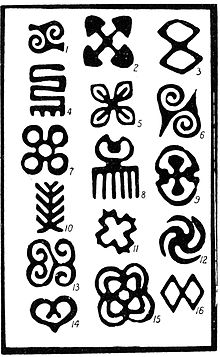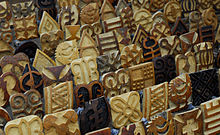Adinkra Ahyɛnsodeɛ
- Wɔatwerɛ nsɛm wei ɛwɔ Asante kasa mu
Adinkra yɛ ahyɛnsodeɛ a egyina hɔ ma nimdeɛ anaa nsɛmfua bi. Mpɛn pii no, ntoma ne nneɛma a yɛde dɔteɛ ayɛ bi ti sɛ, ayowa, kukuo ne nea ɛkeka ho na, Adinkra ahyɛnsodeɛ yi di dwuma paa wɔ mu. Nnipa a na kane no wɔde adinkra de dwuma yiye paa yɛ Asantefoɔ ne Baoulefoɔ a, wotu firi Ghana kɔ bɔɔ adwaa wɔ bɛɛbi foforo. Afei nso, Adinkra ahyɛnsodeɛ yi bɛdii tintinman wɔ wɔn adansie nnwuma nyinaa mu.

Sɛ woba Akan man mu a, yɛde Adinkra toto ahenefo nkonya ho ɛne nneɛma a yɛde sika kɔkɔɔ ayɛ. Afei nso nkonya a yɛde di dwuma wɔfie ne nea nananom ahenefo de di dwuma wɔ wɔn nsɔneɛso no, wobehu adinkra ahyensodeɛ wɔ ho. Nsrahwe ama ɛneɛ adinkra dwuma a na kane no ɛdi no asesa koraa. Seisei, wobehu adinkra ahyɛnsodeɛ wɔ yɛn konmuade ho, nneɛma a yede toto y3nsa, yɛn ntaade mu,yɛn sine twa mu ɛne yɛn nnwuma bebree mu. Adinkra a yedi dwuma beberee no mpenpii no ɛkasa kyerɛ yɛn. Akanfoɔ bu bɛ bi sɛ "Oba nyansafoɔ, yɛbu no bɛ na yɛnka no asɛm". Ne saa nti, yɛbetumi aka sɛ Adinkra ahyɛnsodeɛ no yɛ nyansa kasa bi a yɛn nananom fa so di dii nkɔmo na nne nyinaa, saa nimdeɛ tetefoɔ no di baeɛ no guso wɔ nfasodeɛ bebree.

Wɔdi ahyɛnsodeɛ yi yɛ nseisei nnwuma beberee nanso ɛyɛ adeɛ a ɛsan gyina hɔ ma wɔn nimdeɛ, wɔn gyideɛ ɛne ɔkwan a wɔfa so hunu ɛwiase. Adinkra ahyɛnsodeɛ no gu mu ahodoɔ beberee na ɛmu biara nso wɔ ne kyerɛ aseɛ a mpɛnpii no ɛyɛ abɛbuo. Owura Kwame Anthony Appiah, a ɔwɔ nimdeɛ wɔ Adinkra adesua mu kyerɛmu sɛ, adinkra yɛ kwan baako a Akanfoɔ faso de wɔn gyidie ne nsunsueɛ to dwa.[1]
Abakɔsɛm
sesaWɔ Asante abakɔsɛm mu no, Gyaamanfoɔ a wɔwɔ ɛnɛ Ghana man mu ha na wɔhyɛ ase de adinkra dii dwuma. Obroni a ɔfiri Ohemaa Kurom, owura Thomas Edward Bowdiɔh na ne nsa dii kan sɔɔ Adinkra ntoma mu wɔ afe 1817.[2] Wei kyerɛ sɛ wɔ afe 1817 ne mu nyinaa no, na adinkra wɔhɔ. Owura Bowdich nsa kaa ntoma yi wɔ Asante Mantam kuropong, Kumase. Saa ntoma yi, na adinkra ahyensodeɛ ahodoɔ beyɛ du-num na ɛwɔmu. Ahyensodeɛ ne bi ne nsroma, dono ntoasoɔ, ene diamonds. Nneɛ sɛ yɛkɔ Ohemaa kurom a, yɛbɛhunu saa ntoma yi wɔ wɔn abakɔsɛm fie.
Adinkra ntoma a ɛtɔ so mmienu a akyɛre yiye paa no, yɛhuu nu no afe 1825. Saa ntoma yi wɔfa firi Elmina ɔastle de kɔ Hague abrokyireman. Dutɔhfoɔ asrani panyin F. Last,n'ɔyɛ saa nhyehyɛyɛ yi. Abakɔsɛm kyerɛ a, wɔyɛɛ saa ntoma yi maa William I a ɔfri Netherlands abrokyireman mu. ɛnoti sɛ yɛhwe saa ntoma yi a, yɛbɛhunu Netherlands man no ahyensodeɛ sɛ ɛda mfifini. Adinkra bɛyɛɛ ade sronko bi maa wɔn a wɔbedii Goldɔast man no so. Ne saa ɛnti se wotu kwan kɔ saa aman yi so a wobehunu adinkra ntoma wɔ wɔn abakɔsem fie.[3]
Adinkra Ntoma
sesaAhenfo, adehyeɛ ne ɛtumfoɔ na wɔfura Adinkra ntoma kɔ eyie ne dwabɔ akeseɛ a ɛsombo ase. Kane no na wɔde wɔn nsa na nwene adinkra to ntoma kɔkɔɔ anaa tumtum so. Ahyensodeɛ a wɔde to so no kyere onipa diberɛ ɛne baabia wobetumi ahyɛ ntoma no akɔ. Enam sɛ ɛwiase akɔ n"anim no nti, ɛne yi y3de Adinkra yi to ntoma biara so.
Enɛ yi Ntɔnso a ɛwɔ Kumase kwan so na ɛyɛ baeɛ a wɔyɛ adinkra ntoma yi. Adinkra aduro tumtum a wɔde hyɛ ntoma no, wɔde ɛdua badie no hyɛ nsuom na wanoa ne nhini no ɛne ne n"akyi no afra.[4] Sɛ nsuo no dane tumtum a wɔsɔne so na wa san de asi gya so nnɔhwere beberee kɔsi sɛ ɛmu bɛ pi. Sɛ wɔwie a wɔsusu anammɔn bɛyɛ num ɛne nwɔtwe ansana wɔde agu ntoma no so.
Ahyɛnsodeɛ a Owura Rattray twereɛ
sesaOwura Robert Rattray twereɛ adinkra ahyɛnsodeɛ aduanum-mmiensa ɛne wɔn kyerease wɔ ne nhoma, "Religion and Art" wɔ Asante Kasa mu. (Oxford 1927)
Hye ne so
sesa- [5]Appiah, Kwmae Anthony (1993). In my father's house : Africa in the philosophy of culture (1st paperback edition 1993. ed.). New York: Oxford University Press. ISBN 978-0-19-506852-8
- http://www.stlawu.edu/gallery/education/f/09 textiles/adinkra_symbols.pdf[6]
- "History and Origin of Adinkra Symbols" 25 April 2015.[7]
- "Adinkra Symbols and the Rich Akan Culture". 27 August 2014.[8]
- Adinkra cloth history Archived 2010-06-11 at the Wayback Machine. University at Buffalo.[9]
- "Archived copy". Archived from the original on 2012-03-22. Retrieved 2011-04-13. clickable image on the right links to description[10]
- "Cool Planet - oxfam Education". Oxfam GB. Archived from the original on 2012-07-29. Retrieved 2011-04-16.[11]
- Jansen, P.C.M. (2005). Dyes and Tannins. PROTA (Plant Resources of Tropical Africa). p.102. ISBN 9057821591. Retrieved 2013-06-19[12]
Toaso Kenkan
sesa- The Adinkra dictionary: A visual primer on language of Adinkra by W.Bruce Willis ISBN 09661532-1-9
- Cloth as Metaphor: (re) reading the Adinkra cloth symbols of the Akan of Ghana by Dr. George F. Kojo Arthur.
- Legon, Ghana: Centre for indigenous Knowledge Systems, 2001. 187,{6}, 29 cm. ISBN 9988-0-0791-4
- African Accents: Fabrics and Crafts to Decorate Your Home by Lisa Shepard. ISBN 0-873417895
- Adinkra Symbols: To say bye to a dead relative or friend by Matthew Bulgin.
- Adinkra Symbols
- Adinkra Symbols of West Africa
- Adinkra Symbols at About.com
- ADINKRA - Cultural Symbols of the Asante people
- Adinkra Symbols
- Black Renaissance Man/Adinkra Symbols
- Adinkra Stamps and their Meanings
- Akan Cultural Symbols Project
- Adinkra Symbols Library Project
- Adinkra in Ntonso-Ashanti, Ghana
- Adrinkra symbols and meanings in Spanish Africanidad.com
References
sesa- ↑ Appiah, Kwame Anthony (1993). In my father's house : Africa in the philosophy of culture (1st paperback edition 1993. ed.). New York: Oxford University Press. ISBN 978-0-19-506852-8.
- ↑ Adinkra cloth history Nhwɛsoɔ:Webarchive. University at Buffalo.
- ↑ "Archived copy". Archived from the original on 2012-03-22. Retrieved 2011-04-13.
{{cite web}}: CS1 maint: archived copy as title (link) clickable image on right links to description - ↑ "Cool Planet - Oxfam Education". Oxfam GB. Archived from the original on 2012-07-29. Retrieved 2011-04-16
- ↑ Appiah, Kwmae Anthony (1993). In my father's house : Africa in the philosophy of culture (1st paperback edition 1993. ed.). New York: Oxford University Press. ISBN 978-0-19-506852-8
- ↑ http://www.stlawu.edu/gallery/education/f/09 textiles/adinkra_symbols.pdf
- ↑ "History and Origin of Adinkra Symbols" 25 April 2015.
- ↑ "Adinkra Symbols and the Rich Akan Culture". 27 August 2014.
- ↑ Adinkra cloth history Archived 2010-06-11 at the Wayback Machine. University at Buffalo.
- ↑ "Archived copy". Archived from the original on 2012-03-22. Retrieved 2011-04-13. clickable image on the right links to description
- ↑ "Cool Planet - oxfam Education". Oxfam GB. Archived from the original on 2012-07-29. Retrieved 2011-04-16.
- ↑ Jansen, P.C.M. (2005). Dyes and Tannins. PROTA (Plant Resources of Tropical Africa). p.102. ISBN 9057821591. Retrieved 2013-06-19